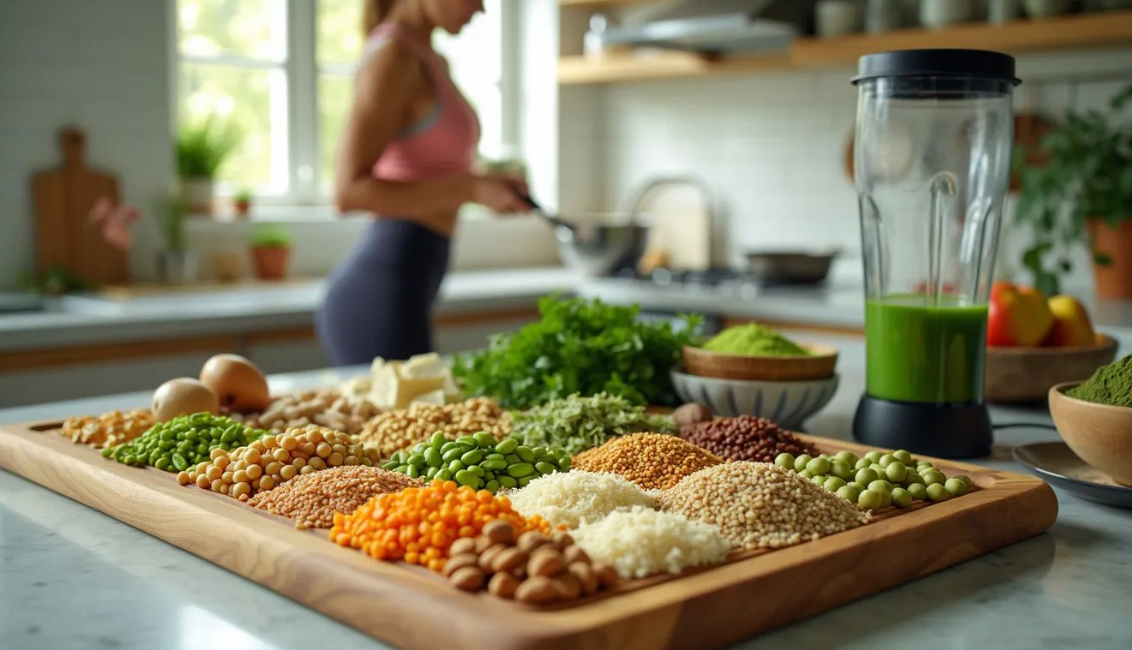Introduction
In recent years, plant-based diets have surged in popularity, driven by concerns for personal health, animal welfare, and environmental sustainability. As more people transition to vegetarian and vegan lifestyles, a crucial question often arises: “Can I get enough protein from plant sources?” The answer is a resounding yes, but it’s not just about quantity—it’s also about quality and how well your body can use the protein you consume. This is where the concept of protein bioavailability becomes crucial.
Protein bioavailability refers to the proportion of protein that your body can effectively absorb and utilize from the food you eat. While plant-based diets can certainly provide adequate protein, plant proteins generally have lower bioavailability compared to animal proteins. However, with the right knowledge and strategies, you can significantly enhance the bioavailability of plant-based proteins in your diet.
This comprehensive guide will delve into the science behind plant protein bioavailability, explore strategies to improve it, and provide practical tips for optimizing your plant-based protein intake. Whether you’re a long-time vegan, a curious flexitarian, or an athlete looking to incorporate more plant-based options into your diet, this article will equip you with the knowledge to make the most of your plant protein sources.
Understanding Protein Bioavailability
Protein bioavailability refers to the proportion of ingested protein that is absorbed by the intestine and becomes available for bodily functions or protein synthesis. In simpler terms, it’s a measure of how efficiently your body can use the protein you consume.
Factors Influencing Protein Bioavailability
- Digestibility: How easily the protein is broken down in the digestive system.
- Amino acid profile: The types and amounts of amino acids present in the protein.
- Anti-nutrients: Compounds that can interfere with protein absorption.
- Processing and preparation methods: How the food is cooked or prepared can affect bioavailability.
Animal proteins generally have higher bioavailability compared to plant proteins due to their complete amino acid profiles and easier digestibility. However, with proper strategies, plant-based diets can easily meet protein needs and offer numerous health benefits.
The Science Behind Plant Protein Bioavailability
Amino Acid Profiles of Plant Proteins
Proteins are made up of amino acids, and there are 20 different amino acids that our bodies need. Nine of these are considered “essential,” meaning our bodies cannot produce them, and we must obtain them from our diet. Most plant proteins are deficient in one or more essential amino acids, which is why combining different plant protein sources is important for those on plant-based diets.
Protein Digestibility-Corrected Amino Acid Score (PDCAAS)
The PDCAAS is a method of evaluating protein quality based on both the amino acid requirements of humans and their ability to digest it. While many plant proteins score lower on the PDCAAS scale compared to animal proteins, combining different plant sources can significantly improve the overall protein quality of a meal.
Anti-Nutrients and Their Impact on Bioavailability
Many plant foods contain compounds known as anti-nutrients, which can interfere with the absorption of proteins and other nutrients. Common anti-nutrients include phytates, tannins, and trypsin inhibitors. While these compounds can reduce protein bioavailability, many of them also have health benefits. The key is to use preparation methods that reduce their impact on nutrient absorption while retaining their beneficial properties.
Strategies to Improve Plant-Based Protein Bioavailability
1. Protein Combining and Complementary Proteins
While it’s not necessary to combine proteins at every meal, consuming a variety of plant proteins throughout the day ensures you’re getting all essential amino acids. This concept is crucial for those following a plant-based athlete diet focused on complete proteins. Some classic combinations include:
- Rice and beans
- Hummus and whole wheat pita
- Peanut butter on whole grain bread
2. Food Preparation Techniques
Soaking and Sprouting
Soaking and sprouting grains, legumes, and seeds can significantly reduce phytate content and increase nutrient bioavailability. For example:
- Soak beans for 8-12 hours before cooking
- Sprout lentils for 2-3 days before consumption
Fermentation
Fermentation not only improves digestibility but also enhances the nutritional profile of foods. Examples include:
- Tempeh (fermented soybeans)
- Sourdough bread
- Miso
Cooking Methods
Certain cooking methods can improve protein digestibility:
- Boiling can reduce trypsin inhibitors in legumes
- Roasting nuts can increase their protein digestibility
3. Enhancing Absorption with Other Nutrients
Combining plant proteins with certain nutrients can enhance their absorption:
- Vitamin C can improve iron absorption from plant sources
- Consuming lysine-rich foods with grains can create a complete protein profile
4. Supplementation Strategies
While whole foods should be the primary focus, supplements can help fill nutritional gaps. Choosing the right vegan protein supplements can be crucial for optimizing protein intake. Options include:
- Plant-based protein powders (pea, rice, hemp)
- Essential amino acid supplements
- Digestive enzymes to aid protein breakdown
Optimizing Bioavailability of Specific Plant Protein Sources
Legumes (beans, lentils, peas)
- Soak and cook thoroughly to reduce anti-nutrients
- Combine with grains for a complete protein profile
- Add vitamin C-rich foods to enhance iron absorption
Nuts and Seeds
- Soak or sprout to reduce phytate content
- Roast lightly to improve digestibility
- Grind flaxseeds and chia seeds for better nutrient absorption
Whole Grains
- Choose sprouted grains when possible
- Combine with legumes for complementary proteins
- Ferment grains (e.g., sourdough bread) for improved digestibility
Soy Products
- Choose fermented soy products like tempeh and miso for improved digestibility
- Limit processed soy products
- Combine with other plant proteins for variety
Plant-Based Protein Powders
- Choose powders with a complete amino acid profile
- Look for products with added digestive enzymes
- Mix with fruits and vegetables for added nutrients
Recent Innovations in Plant Protein
The plant protein industry is rapidly evolving, with new sources and processing techniques emerging. These plant-based protein innovations are revolutionizing the way we think about vegan nutrition.
Novel Protein Sources
- Algae proteins (e.g., spirulina, chlorella)
- Mycoproteins (derived from fungi)
- Insect proteins (for non-vegan options)
Processing Techniques to Improve Bioavailability
- Extrusion technology to improve texture and digestibility
- Enzyme treatments to reduce anti-nutrients
- Ultrasonic treatments to increase protein extraction efficiency
Emerging Plant-Based Protein Products
- Plant-based meat alternatives with improved amino acid profiles
- Fortified plant milks with balanced nutrient compositions
- Novel snack foods incorporating high-quality plant proteins
Plant-Based Protein for Athletes and Fitness Enthusiasts
Athletes and fitness enthusiasts often have higher protein needs, but these can still be met with a well-planned plant-based diet. Understanding complete proteins for plant-based athletes is crucial for optimal performance.
Meeting Increased Protein Needs
- Consume a variety of plant proteins throughout the day
- Increase portion sizes of protein-rich plant foods
- Consider plant-based protein supplements for convenience
Timing of Protein Intake for Optimal Absorption
- Consume protein within 30 minutes post-workout for optimal recovery
- Spread protein intake evenly throughout the day
- Include a protein source with each meal and snack
Vegan Bulking Strategies
For those looking to gain muscle mass on a plant-based diet, implementing effective vegan bulking strategies is essential. This includes:
- Increasing overall calorie intake from whole plant foods
- Focusing on protein-rich plant sources like legumes, nuts, and seeds
- Incorporating resistance training to stimulate muscle growth
Common Concerns and Misconceptions
Protein Deficiency on Plant-Based Diets
Contrary to popular belief, protein deficiency is rare in plant-based diets that include a variety of whole foods. Most people on well-planned plant-based diets easily meet or exceed their protein requirements.
Complete vs. Incomplete Proteins
While many plant proteins are “incomplete,” consuming a variety of plant proteins throughout the day provides all necessary amino acids. It’s not essential to combine proteins at every meal.
Bioavailability and Overall Protein Intake
Even though plant proteins may have lower bioavailability, this can be compensated for by slightly increasing overall protein intake and implementing the strategies discussed in this article.
Nutrient Deficiencies in Vegan Diets
While a well-planned vegan diet can meet most nutritional needs, some nutrients require special attention. Vegan B12 and iron supplements for athletes can be crucial for maintaining optimal health and performance.
Practical Tips for Improving Plant Protein Bioavailability
Meal Planning Strategies
- Plan meals that include a variety of plant protein sources
- Incorporate protein-rich snacks between meals
- Use a meal planning app to track protein intake and amino acid balance
Smart Food Combinations
- Pair iron-rich plants (spinach, lentils) with vitamin C sources (citrus fruits, bell peppers)
- Combine grains and legumes in meals (e.g., rice and beans, hummus and pita)
- Add nuts or seeds to salads and smoothies for an extra protein boost
Preparation and Cooking Tips
- Soak beans and grains overnight before cooking
- Sprout lentils and other legumes for a few days before use
- Use fermentation techniques for improved digestibility (e.g., sourdough bread, homemade plant-based yogurts)
Conclusion
Optimizing plant-based protein bioavailability is key to thriving on a vegan or vegetarian diet. By understanding the science behind protein absorption and implementing the strategies discussed in this guide, you can ensure that your body makes the most of the plant proteins you consume.
Remember, the key to a successful plant-based diet is variety. Consume a wide range of plant proteins, prepare them properly, and combine them wisely. With these strategies, you can meet your protein needs, support your fitness goals, and contribute to a more sustainable food system.
As research in this field continues to evolve, stay informed about new developments and innovations in plant-based nutrition. The future of plant protein is bright, with ongoing advancements promising even more efficient and sustainable ways to meet our nutritional needs.
Frequently Asked Questions
Can I get enough protein on a plant-based diet?
Yes, it’s entirely possible to meet your protein needs on a plant-based diet. By consuming a variety of plant protein sources and implementing strategies to improve bioavailability, you can ensure adequate protein intake.
Do I need to combine proteins at every meal?
No, it’s not necessary to combine proteins at every meal. Consuming a variety of plant proteins throughout the day is sufficient to meet your amino acid needs.
How can I increase iron absorption from plant-based sources?
Combine iron-rich plant foods with sources of vitamin C, and use preparation methods like soaking and sprouting to reduce phytates that can inhibit iron absorption.
Are plant-based protein powders as effective as whey protein?
Many plant-based protein powders are formulated to be complete proteins and can be just as effective as whey protein. Look for options that contain a blend of plant proteins or are fortified with additional amino acids.
How does processing affect plant protein bioavailability?
Processing can both positively and negatively affect bioavailability. Some processes (like fermentation) can improve digestibility, while others (like high-heat processing) may decrease nutrient availability. Generally, minimally processed whole foods offer the best nutritional value.



